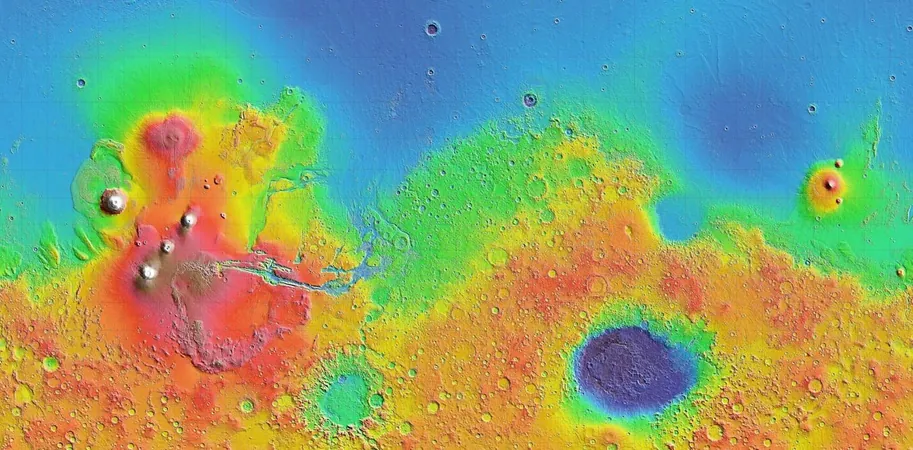
Unveiling the Martian Dichotomy: Could 'Marsquakes' Hold the Key to Understanding the Planet’s Uneven Landscape?
2025-01-18
Author: Sophie
The Mysterious Landscape of Mars
Mars has long captivated scientists with one of the most intriguing mysteries of the solar system—the Martian dichotomy. First discovered in the 1970s by the Viking missions, this phenomenon showcases a stark contrast in elevation and geological characteristics between the planet’s southern highlands and northern lowlands.
The southern highlands, which account for approximately two-thirds of Mars' surface, soar 5 to 6 kilometers higher than the smooth, crater-scarce northern lowlands. This notable altitudinal disparity is not the only point of interest; the southern region is heavily cratered and features signs of ancient volcanic activity, while the northern plains are remarkably flat.
Geophysical measurements have revealed that Mars’ crust is considerably thicker under the southern highlands, accompanied by magnetized rocks indicative of a time when Mars boasted a global magnetic field, a phenomenon that seems absent in the northern areas. The age of these surfaces is further highlighted by the varying density of impact craters, providing a glimpse into the planet’s history.
Could Mars Have Hosted Oceans?
Intriguingly, scientists speculate that a vast ocean of liquid water may have once existed in the northern lowlands. The ongoing debate surrounding this hypothesis hinges on the evidence of sediments, unique landforms, and minerals typically associated with oceanic environments, raising critical questions about the planet’s potential to harbor life.
The Theories Behind the Dichotomy
To explain the Martian dichotomy, researchers have proposed two main hypotheses.
1. **Endogenic Hypothesis**: This theory focuses on internal processes within the Martian mantle, suggesting that differential heat transfer and tectonic activity led to the development of the dichotomy over time.
2. **Exogenic Hypothesis**: Alternatively, this perspective proposes that external forces, perhaps a cataclysmic impact from a large celestial body, may have reshaped Mars' surface, creating the vast differences we observe.
The Role of Marsquakes in Decoding the Mystery
NASA’s InSight lander has been key in studying "marsquakes," which occur due to geological activity on the planet’s surface. Unlike Earth, where seismometers are plentiful, Mars relies on a single instrument for data. By analyzing the travel times of seismic waves generated by marsquakes, scientists can decipher their locations and the geological conditions of the regions affected.
Recent studies have shown that marsquake waves lose energy more quickly as they travel through the southern highlands compared to the northern lowlands—indicative of hotter rocks beneath the southern terrain. This revelation aligns with the idea that internal forces, rather than external impacts, shaped the dichotomy.
New Insights into Mars' Tectonic Past
This temperature gradient may reveal that early in its history, Mars experienced tectonic plate movements similar to those of Earth. Over time, this led to a unique geological makeup that became "frozen" when tectonic activity ceased, resulting in the planetary "stagnant lid." The patterns of convective currents in Mars’ molten interior likely contributed to the dichotomy’s formation—with upwelling beneath the highlands and downwelling beneath the lowlands.
Looking Ahead
While this research sheds light on the Martian dichotomy, questions remain. To deepen our understanding, scientists will require more data on marsquakes alongside comprehensive models illustrating Mars' formation. With these tools, they hope to unveil the enigmatic past of Mars and, ultimately, assess our neighboring planet's potential for life.
As exploration of Mars continues, tantalizing possibilities arise regarding its history and the geological forces that have shaped it. Stay tuned for more revelations as we probe deeper into this celestial enigma!









 Brasil (PT)
Brasil (PT)
 Canada (EN)
Canada (EN)
 Chile (ES)
Chile (ES)
 Česko (CS)
Česko (CS)
 대한민국 (KO)
대한민국 (KO)
 España (ES)
España (ES)
 France (FR)
France (FR)
 Hong Kong (EN)
Hong Kong (EN)
 Italia (IT)
Italia (IT)
 日本 (JA)
日本 (JA)
 Magyarország (HU)
Magyarország (HU)
 Norge (NO)
Norge (NO)
 Polska (PL)
Polska (PL)
 Schweiz (DE)
Schweiz (DE)
 Singapore (EN)
Singapore (EN)
 Sverige (SV)
Sverige (SV)
 Suomi (FI)
Suomi (FI)
 Türkiye (TR)
Türkiye (TR)
 الإمارات العربية المتحدة (AR)
الإمارات العربية المتحدة (AR)